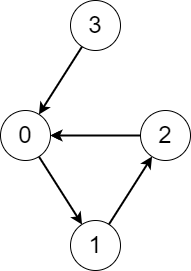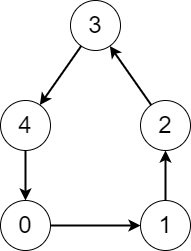Description
There is a directed graph consisting of n nodes numbered from 0 to n - 1 and n directed edges.
You are given a 0-indexed array edges where edges[i] indicates that there is an edge from node i to node edges[i].
Consider the following process on the graph:
- You start from a node
xand keep visiting other nodes through edges until you reach a node that you have already visited before on this same process.
Return an array answer where answer[i] is the number of different nodes that you will visit if you perform the process starting from node i.
Example 1:

Input: edges = [1,2,0,0] Output: [3,3,3,4] Explanation: We perform the process starting from each node in the following way: - Starting from node 0, we visit the nodes 0 -> 1 -> 2 -> 0. The number of different nodes we visit is 3. - Starting from node 1, we visit the nodes 1 -> 2 -> 0 -> 1. The number of different nodes we visit is 3. - Starting from node 2, we visit the nodes 2 -> 0 -> 1 -> 2. The number of different nodes we visit is 3. - Starting from node 3, we visit the nodes 3 -> 0 -> 1 -> 2 -> 0. The number of different nodes we visit is 4.
Example 2:

Input: edges = [1,2,3,4,0] Output: [5,5,5,5,5] Explanation: Starting from any node we can visit every node in the graph in the process.
Constraints:
n == edges.length2 <= n <= 1050 <= edges[i] <= n - 1edges[i] != i
Solution
Python3
class Solution:
def countVisitedNodes(self, edges: List[int]) -> List[int]:
N = len(edges)
# Kosaraju's Algorithm to find Strongly Connected Components (SCC)
# First DFS on the graph to generate toposort
visited = [False] * N
topo = []
def dfs(node):
if visited[node]: return
visited[node] = True
dfs(edges[node])
topo.append(node)
for node in range(N):
dfs(node)
# reverse the graph
transpose = defaultdict(list)
for node, adj in enumerate(edges):
transpose[adj].append(node)
# Second DFS on the reversed graph to find the cycles
visited = [False] * N
comp = 0
scc = [-1] * N
sccList = [[] for _ in range(N)]
def dfs2(node):
if visited[node]: return
visited[node] = True
scc[node] = comp
sccList[comp].append(node)
for adj in transpose[node]:
dfs2(adj)
while topo:
node = topo.pop()
if not visited[node]:
dfs2(node)
comp += 1
sccCount = [0] * N
for count in range(comp - 1, -1, -1):
sccCount[count] = len(sccList[count])
for node in sccList[count]:
adj = edges[node]
if scc[adj] != count:
sccCount[count] += sccCount[scc[adj]]
return [sccCount[scc[node]] for node in range(N)]